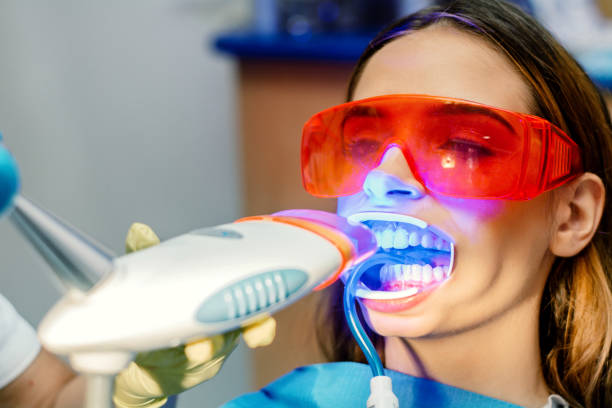
15 Jan Is Teeth Whitening Safe During Pregnancy?
Have you looked in the mirror lately? I’m sure you have. If you’re like many people, you have to glance at your pearly whites to make sure that they are white. While standard mouth care helps, many still would rather try teeth whitening. Teeth whitening has become one of the most sought-after cosmetic dental procedures in recent years.
The demand for brighter, whiter smiles is driven by societal pressures, advancements in dental technology, and an increasing focus on aesthetics. This blog explores why teeth whitening is so popular, what ingredients are typically found in whitening products, and the potential risks associated with the procedure.

Why Teeth Whitening is Popular
1. Cultural Emphasis on Aesthetics
A bright smile is often associated with youth, health, and beauty. Media and advertising campaigns perpetuate the idea that white teeth are a hallmark of attractiveness. Celebrities, influencers, and public figures frequently display gleaming smiles, setting a standard that many strive to emulate.
2. Boosting Confidence
A whiter smile can significantly enhance self-esteem. People often feel more confident in social and professional settings when they are not self-conscious about stained or discolored teeth. This boost in confidence can positively affect personal and professional relationships.
3. Accessibility of Products and Services
Teeth whitening is no longer limited to the dentist’s office. Over-the-counter (OTC) products such as whitening strips, toothpaste, and gels have made it easier and more affordable for consumers to achieve whiter teeth. Additionally, at-home professional kits prescribed by dentists offer convenience while maintaining effectiveness.
4. Advancements in Technology
Innovations in dental technology have made teeth whitening faster, safer, and more effective. Laser whitening, LED light-activated treatments, and improved formulas have contributed to the growing popularity of the procedure.
5. Addressing Stains from Modern Lifestyles
Modern diets and habits, such as drinking coffee, tea, red wine, or smoking, often lead to tooth discoloration. Teeth whitening offers a solution to combat these stains and restore the natural brightness of teeth.
What Makes Up Teeth Whitening Products?
Teeth whitening products contain active ingredients designed to remove stains and lighten the natural color of teeth. Here are the key components:
1. Hydrogen Peroxide
Hydrogen peroxide is a common active ingredient in both professional and OTC whitening products. It acts as a bleaching agent by breaking down stains on the enamel into smaller molecules, making them less visible.
2. Carbamide Peroxide
Carbamide peroxide is another widely used ingredient, especially in at-home whitening kits. It breaks down into hydrogen peroxide and urea, with hydrogen peroxide being the active bleaching agent. Carbamide peroxide typically works slower than hydrogen peroxide but is gentler on the teeth.
3. Abrasives
Many whitening toothpastes contain mild abrasives like silica or baking soda. These ingredients help remove surface stains caused by food, drinks, and smoking. However, they do not alter the intrinsic color of teeth.
4. Desensitizing Agents
To counteract sensitivity, some products include ingredients like potassium nitrate or fluoride. These agents help soothe the nerves inside the teeth and strengthen enamel.
5. LED Lights
Although not a chemical ingredient, LED lights are often used in conjunction with whitening gels to accelerate the bleaching process. The light activates the hydrogen peroxide, enhancing its effectiveness.
6. Fluoride
Fluoride is sometimes added to whitening products to help strengthen enamel and reduce the risk of decay or sensitivity during the whitening process.

Are There Dangers to Teeth Whitening?
While teeth whitening is generally considered safe, it is not without risks. Understanding these potential dangers can help consumers make informed decisions about the procedure.
1. Tooth Sensitivity
Sensitivity is one of the most common side effects of teeth whitening. Whitening agents can temporarily weaken the enamel, exposing the dentin layer beneath. This exposure can lead to discomfort, especially when consuming hot or cold foods and drinks. Sensitivity usually subsides within a few days after treatment.
2. Gum Irritation
Whitening gels can sometimes irritate the gums, particularly if they come into direct contact with the soft tissue. This irritation can cause redness, swelling, or a burning sensation. Proper application and the use of protective barriers can minimize this risk.
3. Overuse and Enamel Damage
Excessive or repeated use of whitening products can lead to enamel erosion. Once the enamel is worn down, it cannot regenerate, leaving teeth more vulnerable to decay and sensitivity. It’s crucial to follow the recommended guidelines and avoid over-whitening.
4. Uneven Whitening
Teeth whitening may not be effective on all types of discoloration. For example, intrinsic stains caused by trauma or medication may not respond well to bleaching agents. Additionally, dental restorations like crowns, veneers, or fillings do not whiten, potentially leading to uneven coloration.
5. Allergic Reactions
Some individuals may be allergic to the ingredients in whitening products, such as hydrogen peroxide or flavoring agents. Symptoms can include itching, swelling, or difficulty breathing. It’s essential to conduct a patch test or consult a dentist before starting any whitening treatment.
6. Potential for Increased Decay
While not directly caused by whitening products, enamel erosion from overuse can increase the risk of cavities. Weakened enamel is less effective at protecting teeth from bacteria and acids.
7. Temporary Results
Teeth whitening is not permanent. The results can fade over time, especially with the continued consumption of staining foods and beverages. This may lead some individuals to overuse products in an attempt to maintain their results.
Is Teeth Whitening Safe During Pregnancy?
The safety of teeth whitening during pregnancy is a topic of concern for many expectant mothers. While there is limited research specifically addressing this issue, dental professionals generally recommend caution.
1. Potential Risks of Whitening Agents
Whitening products often contain hydrogen peroxide or carbamide peroxide, which can be absorbed into the bloodstream in small amounts. Although the risk to the fetus is considered low, the lack of conclusive studies makes it advisable to avoid these agents during pregnancy.
2. Increased Sensitivity During Pregnancy
Hormonal changes during pregnancy can lead to increased gum sensitivity and a higher risk of gingivitis. Using whitening products during this time may exacerbate discomfort or irritation.
3. Focus on Oral Health
Maintaining good oral hygiene is especially important during pregnancy. Regular brushing, flossing, and dental check-ups should take precedence over cosmetic procedures like teeth whitening.
4. Safe Alternatives
Expectant mothers can consider non-chemical alternatives to improve the appearance of their teeth, such as using whitening toothpaste with mild abrasives or avoiding staining foods and beverages.
Tips for Safe Teeth Whitening
- Consult a Dentist: Always seek professional advice before starting any whitening treatment. A dentist can assess the condition of your teeth and recommend the most appropriate method.
- Follow Instructions: Adhere to the guidelines provided with any whitening product to avoid overuse or misuse.
- Use Desensitizing Products: If sensitivity occurs, consider using toothpaste or gels designed for sensitive teeth.
- Limit Staining Foods and Drinks: Reducing the intake of coffee, tea, red wine, and similar items can help prolong whitening results.
- Avoid Smoking: Tobacco products are a major cause of staining and can quickly reverse whitening effects.
- Maintain Good Oral Hygiene: Regular brushing, flossing, and dental check-ups can help keep your teeth white and healthy.
Here Is The Gist
Teeth whitening’s popularity stems from its ability to enhance appearance, boost confidence, and address modern lifestyle challenges. With a variety of products and procedures available, achieving a brighter smile has never been more accessible. However, it’s important to understand the ingredients in whitening products and be aware of potential risks.
By consulting with a dental professional and following safe practices, individuals can enjoy the benefits of teeth whitening while minimizing any adverse effects. A radiant smile is undoubtedly a valuable asset, but it should be pursued responsibly and with care.


Sorry, the comment form is closed at this time.